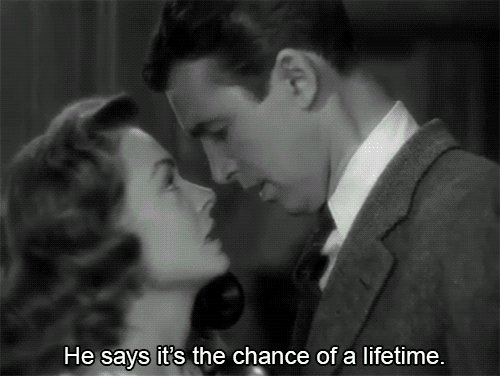Retro Crimbo: Attaboy, Clarence! It’s A Wonderful Life hits 75

You want the moon? It’s A Wonderful Life has been delivering its marvellous movie magic to generations of film fans for 75 years – all with an irresistible sprinkling of festive goodwill and joy
As, for many of us, this year’s festive season draws to a close, we’re left to reflect on another twelve months that, while compromised for many millions of us, may well, too, have featured many highs and many lows. At times like this, then, and at any time of the year, frankly, during this unsettling, pandemic-wracked era, it’s definitely good for us all to seek some solace and comfort.
And how better to do that than with an utterly heartwarming, undeniably brilliant flick? It’s A Wonderful Life, every single time you give it a watch, ticks all those boxes. And has done so now for 75 years. Yes, Frank Capra’s much-loved festive-fest of frothily-fun-cum-dark-cum-cheery genius has been around for three-quarters of a century. Reason, indeed, methinks for a celebratory post on this blog – featuring behind-the-scenes facts and pics. I can’t say giving it a read will ensure an angel gets its wings, but who knows? It just might… so, go on, why not give it a go…
.
CLICK on the images for full size
.
It’s A Wonderful Life is based on a 1943 short story, The Greatest Gift, written by Philip Van Doren. Curiously, Van Doren struggled to interest publishers in his story, so instead printed 200 copies of it and, as a Christmas gift, gave them to friends, to relatives and – in a genius move – to his Hollywood agent.
Impressed, the agent sold the story’s rights to the RKO film studio, where a producer was impressed enough to share it with Cary Grant, whom, in turn, was impressed enough to want to make it and play the lead character, George Bailey.
.


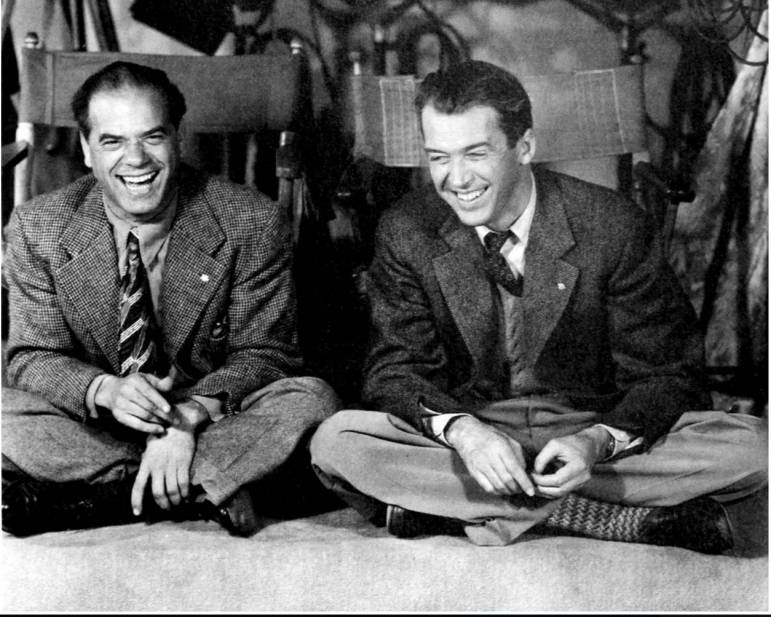
Perfect pairing: Capra and Stewart shooting the breeze on set (l & r); the latter checking his script (m)
Eventually, the story was discovered by top-tier producer-director Frank Capra, whom bought the rights from RKO for his then new studio, Liberty Films. Obviously, Cary Grant didn’t end up as George Bailey; James Stewart did (whom had previously collaborated with Capra on 1938’s You Can’t Take It with You and 1939’s Mr. Smith Goes to Washington). But why?
In his autobiography, Capra wrote: “Of all actors’ roles, I believe the most difficult is the role of a Good Sam who doesn’t know that he is a Good Sam. I knew one man who could play it … James Stewart. … I spoke to Lew Wasserman, the MCA agent who handled Jimmy, told him I wanted to tell Jimmy the story. Wasserman said Stewart would gladly play the part without hearing the story”.
Cast as Mary Hatch, George Bailey’s irresistibly lovely love-interest and eventual wife, was the irresistibly lovely Donna Reed. Now, through her Hollywood roles, Reed had nurtured a girl-next-door persona, but had actually grown up on an Iowa farm. Apparently, thesping great Lionel Barrymore (cast as the Scrooge-like local tycoon-cum-villain Mr Potter) found the juxtaposition of Reed’s image and background unlikely, so in a $50-bet he challenged her to milk a cow.
Reed would go on to claim that, in her long, distinguished career, it was the easiest $50 she ever earned.
.
.
Talking of Potter appearing to be a thinly veiled version of Dickens’ most famous creation, an FBI memo dated May 26th 1947 actually suggests the Feds were concerned about the film’s supposed ‘Communist’ content. The memo read: “It’s A Wonderful Life represented rather obvious attempts to discredit bankers by casting Lionel Barrymore as a ‘Scrooge-type’ so that he would be the most hated man in the picture. This … is a common trick used by Communists”.
Crazy as the Feds’ fears may seem today, perhaps they were on to something because Dalton Trumbo (whom, years later, famously ended up blacklisted because he wouldn’t ‘name names’ to the House on Un-American Activities Committee) was one of several uncredited writers whom Capra collaborated with on the script. Another of the uncredited scribes was Dorothy Parker.
.
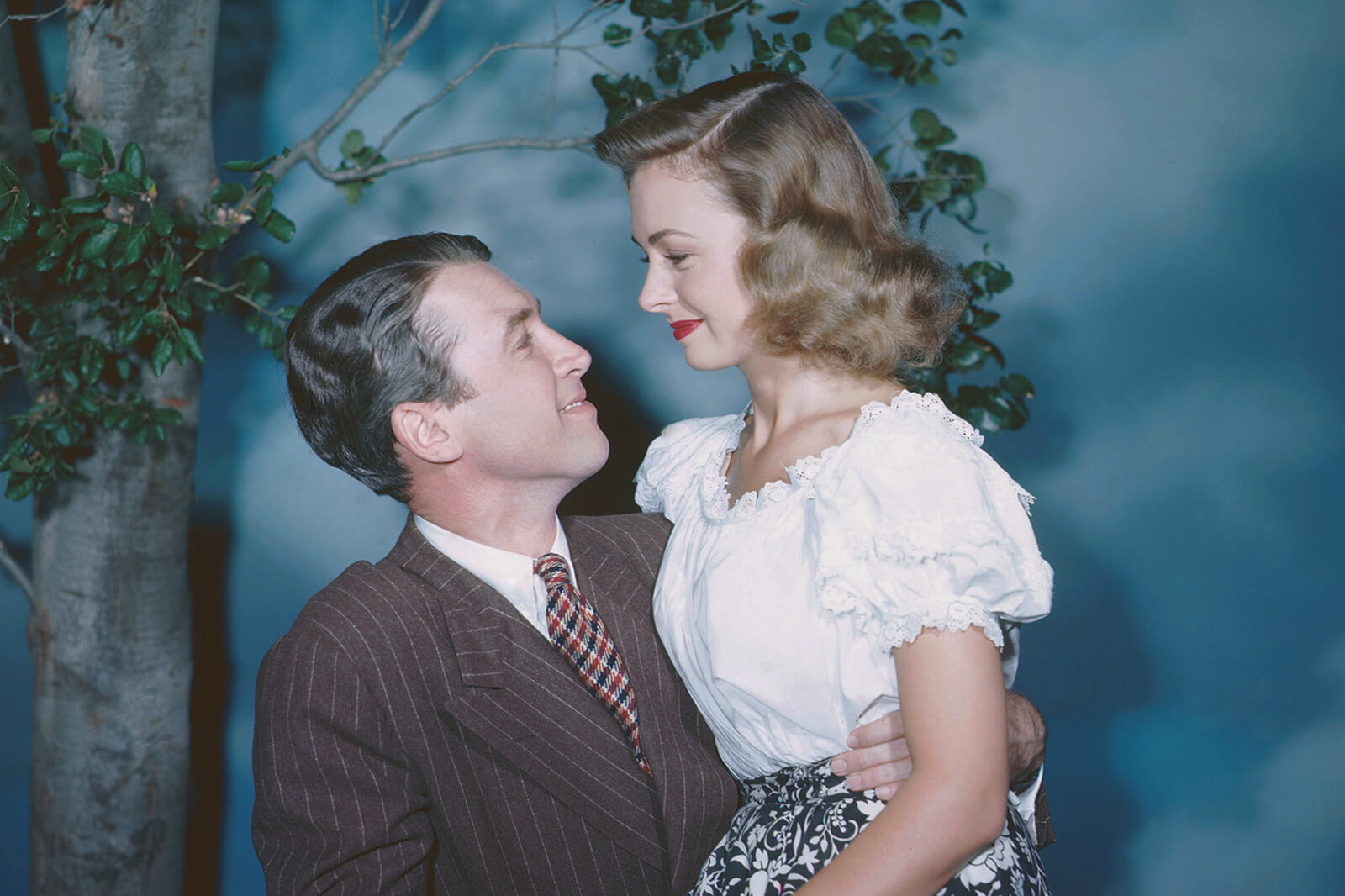
Marriage and wonderful strife: the movie’s two stars posing together in a colour publicity shot
Constructed in eight weeks in Encino, California, the movie’s exterior sets (for the fictitious upstate New York town Bedford Falls) were among the largest built by Hollywood up until that point. They featured more than 75 buildings scattered across four acres and included the now iconic 300-yard-long main street and 20 fully-grown oak trees.
Elsewhere, one of the movie’s biggest interior locations, the high school gym, was actually Beverly Hills High School. Its retractable floor, under which lies a 75-foot-long swimming pool, made for an unforgettable sequence, of course, when the floor’s opened by a revenge-seeking would-be paramour of Mary; his attentions having been thwarted by George. The facility exists to this day – it’s affectionately referred to as the ‘Swim Gym’.
.

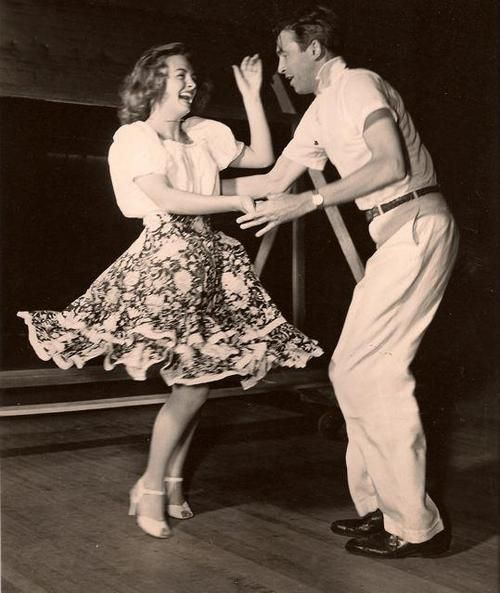
Strictly gym dancing: Stewart and Reed learning and rehearsing their dance steps for the gym scene
Despite its decades-and-decades-long association with Christmas (owing to the time of year when its conclusion takes place), It’s A Wonderful Life was shot during a scorching hot Californian summer. Indeed, conditions got so hot and sticky that production had to be halted more than once. In fact, that’s not melted snowflakes on Stewart’s face during the legendary bridge scene; it’s sweat – temperatures exceeded 30°C on that day of filming.
When it did come to the on-screen snow, though, It’s A Wonderful Life broke new ground. Artificial (of course!), what features in the movie was a brand new, more authentic-looking creation; a mixture of sugar, shaved ice, soapy water and Foamite (which is commonly used in fire extinguishers). As much as 6,000 gallons of the stuff was blown about to blanket the Bedford Falls set.
.


Groundbreaking snow and sweat-covered pros: surprisingly filmed at the height of summer, It’s A Wonderful Life’s shoot generated several unexpected challenges for Capra, his cast and his crew
During filming – and maybe surprisingly – the wholesomeness that Reed imbued Mary with rather threw Stewart, whom hadn’t felt she was right for the role. So much so that shooting the passionate kissing scene between the two characters was put off for two weeks.
When asked later, Stewart claimed of the scene’s eventual filming: “I was so nervous. There was real electricity in the air. I asked Donna if she wanted to rehearse and she said, ‘Why don’t we just do it?’ and Capra, knowing what was going on, agreed. So there we were, cheek to cheek, no rehearsals, hormones out of control, and Capra says: ‘Action!’ Well, we did it in one take. One of the best things I’ve ever done”.
.
.
Legendary comic actor, W.C. Fields was initially considered for the role of George’s loveable but forgetful Uncle Billy, whose critical mistake of misplacing the bank’s envelope of money sets in motion the events of the movie’s third act (including, of course, the intervention of Clarence the trainee angel and the George-less alternate, dystopian reality). Cast in the part instead was Thomas Mitchell, famous for playing the father of Scarlett O’Hara in Gone With The Wind (1939).
Meanwhile, for Bedford Falls’ good-time girl Violet Bick, Capra had wanted an actress who could play ‘a good bad girl’. Gloria Grahame won the role and, like Donna Reed, would eventually go on to win a Best Supporting Actress Oscar (for 1952’s The Bad And The Beautiful; Reed won hers a year later for her performance in From Here To Eternity).
.

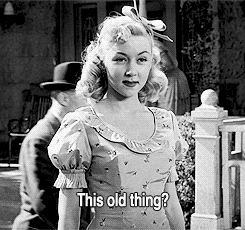
Classic cast and golden Grahame: the movie’s thesps in a full-cast, in-character group-shot (right) and the glorious Gloria Grahame in action as irrepressible but good-hearted Violet Bick (left)
Returning to that iconic-for-all-times scene on the bridge, George recognises he’s alive and back in his own reality again when he feels and extracts from his pocket Zuzu’s petals – the petals that had fallen off Zuzu’s flower, to her disappointment, so he’d pretended to reattach them but slyly put them in his pocket. Today, both a flower shop in NYC’s Brooklyn and a Minneapolis rock band go by the name ‘Zuzu’s Petals’.
Inexplicably, though, the one-time child actor Karolyn Grimes, whom played Zuzu, had to wait until 1979 to first see the film, later explaining: “I never saw movies I was in because my mom told me that would be prideful, being stuck on yourself”.
Another influence on pop culture the movie can proudly claim involves, yes, Muppets – or at least their very near cousins. To wit, the much-adored Sesame Street ‘couple’ that’s Bert and Ernie were named after George Bailey’s friends, Bert the policeman (Ward Bond) and Ernie the taxi driver (Frank Faylen).
.

From Bedford Falls to Sesame Street: sb1991 on devianart’s brilliant Bert and Ernie fan art mash-up
However, in one of oh-so many cases of Oscar getting it wrong, It’s a Wonderful Life was nominated for six Academy Awards (including Best Picture, Director and Actor) but didn’t win any. In a year that also saw the release of the awesome Bogart-Bacall film noir The Big Sleep, the Best Picture Oscar went to WWII-era drama The Best Years Of Our Lives. Its director (William Wyler) and lead actor (Frederic March) won in their respective Oscar categories, too.
In fact, despite its enormous popularity in recent decades, It’s A Wonderful Life wasn’t even a convincing hit following its release (December 20th 1946). With a budget of $2.3 million, expensive for its time, it required bumper business to be deemed successful, but by raking in just $3.3 million from its theatrical run, Liberty Films managed to lose $525,000 on the film.
All that’s long forgotten today, though. Indeed, following its emergence as the pre-eminent classic Christmas flick, it’s now made in excess of $70 million in DVD sales, as well as generating ever-growing profits from modern-day merchandise. Not that any of that’s compensation for Liberty Films – the company was sold to Paramount Pictures in 1947.
.

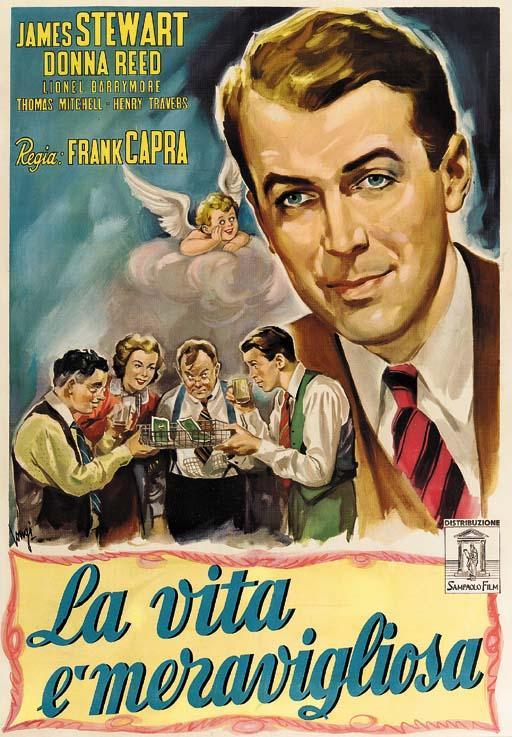

George Bailey goes global: the movie’s original French, Italian and Spanish posters (left to right)
Yet, the film wasn’t actually intended to be released in time for Christmas, let alone become regarded as a ‘Christmas movie’ (if such a notion existed back in 1946). Initially, its release was scheduled for January 1947 but was pushed forward due to buzz around its obvious quality so it might qualify for the 1946 Oscars.
In the final analysis, though, if It’s A Wonderful Life is about and encompasses anything then it’s surely the ideals of doing good, putting things right and, ultimately, destiny. Just like Clarence getting his wings, the film was destined to and eventually did become an all-time Hollywod Holidays classic – not least because that basically happened due to a mistake.
In 1974, nearly 30 years after its theatrical release, the film’s copyright wasn’t renewed, which meant that, over the next two decades, It’s A Wonderful Life wasn’t owned by anyone and happily drifted about in the public domain, meaning TV channels across the United States (and overseas) could freely broadcast it as much as they wanted, every December – and ensure the whole world embraced it and claimed it for themselves.
That’s a Hollywood fairy tale ending, right there. Attaboy, Clarence!
.


